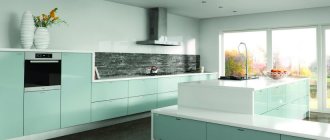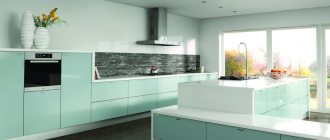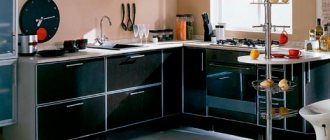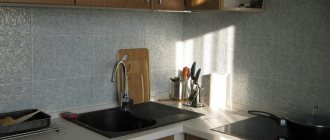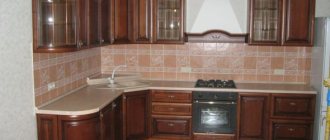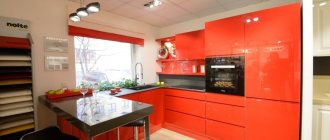Modern kitchens cannot do without a huge number of various household appliances, the operation of which requires a power source. In this matter, the main thing is not to overdo it and maintain the chosen interior style. Pull-out sockets for the kitchen are considered quite an interesting and unusual choice. Often such products are designed for countertops. They help organize your workspace rationally and correctly.
Possible options
Modules of this kind are considered an original solution in any kitchen. They are practical to use and often complement the design of the room. Currently, you can purchase a variety of models, unusual designs in the desired color.
A luxurious solution is the use of sockets built into the kitchen cabinet. This is an excellent analogue of an extension cord, which significantly simplifies the operation of household appliances.
According to their design, sockets are distinguished between horizontal and vertical placement.
Vertical sockets are manufactured with different heights and have certain functionality. Particularly popular are low versions in which the connectors are arranged in a circle.
There are options for two, three, five or more blocks, placed one above the other. They are relevant not only for connecting kitchen appliances, but also, for example, chargers.
Horizontal blocks are made with different numbers of power connectors. Now you can even purchase sockets with integrated input for the Internet, HDMI and USB.
Depending on the design, built-in blocks are:
- rotary;
- away.
Sockets can change their position in space around an axis by 360 or 180 degrees, respectively.
A number of manufacturers equip their products with additional lighting, due to which the room acquires a special, mysterious atmosphere.
The greatest reliability and ease of operation are typical for rotary sockets. Disadvantage: difficulty in simultaneous use of several devices with an “L-shaped” plug.
Recessed socket blocks are usually located in various places in the kitchen area, including: the countertop; wall cabinet; baseboard under the apron.
They are considered universal, since installation of the same block is often possible in different parts and elements of the kitchen. This type of socket can be placed in almost any convenient place on the headset.
It is important to consider that when choosing furniture fittings, you must always pay attention to its degree of protection. It is desirable that the hidden modules meet the IP44 requirements, since the kitchen is considered a room with high humidity, as well as a place where there is a possibility of small particles, dirt, etc. getting into the working elements.
Main types
The variety of models is divided into three groups:
- Open sockets. Appliances recessed into the surface of the countertop are accessible for free entry of water and debris. So, for the most part, they prefer to install such devices not in the kitchen work area, but in tables in various office spaces. They will not interfere with the layout of papers, and at the right time will provide power for the necessary equipment.
- Vertical. They can have a round or rectangular cross-section, and are often equipped with gas shock absorbers for smooth extension. To get such a block, you just need to press the lid and then pull it a little. After releasing the stopper, the entire structure can be easily recessed.
It must be remembered that when connecting electrical appliances, vertical sockets should be supported by hand, otherwise they may not withstand the force due to the rather large lever.
- Horizontal. The block of built-in sockets, after pressing the stainless steel cover, rotates on its axis and the connectors for connection open. Such devices have some inconveniences: it is not always comfortable to insert the power cord into them if the plug is attached at a right angle. It can simply rest against the surface of the countertop.
Specifics of retractable blocks
Considering the comfort and ease of use of hidden sockets, the fittings can even be compared with built-in household appliances and corresponding cabinet kitchen furniture.
Thanks to their small dimensions, the blocks help to rationally use free space and simplify food preparation.
In fact, you can actually install them yourself, since you won’t have to install electrical lines and install boxes for sockets.
Hidden sockets can be chosen in almost any design and functionality. It would be good if they had grounding contacts.
The fittings are supplied with a 1-3 meter cord and plug, making it possible to connect it to household voltage. In some cases, units are produced without a plug, which allows you to further increase the cable length. An excellent choice are reusable collapsible forks.
The design of the retractable socket block is extremely clear. Initially it is hidden in the countertop or upper cabinet. To reach the sockets, you need to lightly press the top panel. After this, the block “moves out” by 10-20 mm, and you can manually move it to the required height or fix it in a given position - there is a corresponding button on the side. This way, you can do without carrying anything in the kitchen and not have to look for a free socket on the apron.
After finishing work with the retractable unit, it can be easily hidden in the tabletop by applying light pressure.
The vertical version can be equipped with additional ports for connecting audio, video equipment, devices with USB connectors, and others. There are also special blocks that are retracted into a niche along with the plugs of connected devices.
Rotary pull-out units with a mechanism activated by pressing on the surface of the lid are in great demand. The module moves out with a light touch - while the power sockets can be rotated to the required convenient position, at a given angle.
The angle depends on the selected model and can reach up to 180 degrees. This parameter is usually indicated on the product packaging.
The retractable rotary unit is often not equipped with a wire and plug, so do not forget to provide for this point.
Features of the built-in socket
It’s worth saying right away that hidden sockets do not differ in functionality from ordinary ones. Essentially, this is a standard surge protector or socket on an extension cord. The difference is purely decorative. They can be hidden or retractable. They are often embedded into the surface of the headset - this way they do not spoil the design and are always at hand.
All wires are located under surfaces (usually under countertops), so they do not get tangled underfoot. In addition, experienced designers place them directly near the places where they are used. Therefore, even if the mixer or coffee grinder has a short cord, this will not cause problems - you will not have to use additional extension cords.
Selection and installation of retractable units
There are no particular problems with how to remove a retractable socket from under the tabletop. The main attention should be paid to the model being purchased and its compliance with key requirements. The right choice allows you to subsequently receive positive emotions from using the right accessories. For an uninitiated buyer, understanding the variety offered on the market turns out to be difficult.
Consider how many power connectors you need in a hidden receptacle. Pay special attention to the total power of the equipment that will be used. Most often these are blocks designed for loads up to 3.5 kW. Relevant information can be found on the product packaging or instructions supplied with it.
Stylish and functional addition
Blocks of built-in sockets are often supplemented with USB and HDMI connectors. This enhances the purpose of the kitchen, which means you can not only cook, but also conveniently use tablets, phones, laptops and other devices from which you can:
- Watch your favorite TV series;
- Conduct online negotiations with loved ones;
- Look for interesting recipes for preparing goodies for your household.
Some information about the manufacturers
When purchasing recessed sockets, you must place your bet on a trusted manufacturer. The most popular today are the products of the German company Evoline, the Swiss company Kondator, and the Italian factory Simon Connect. From the French it is worth highlighting Schneider Electric, the Poles - GTV, and the Russians - Ekoplast. Most often, submersible sockets are made from high-quality and durable materials.
Companies that have been in the kitchen accessories market for a long time try to monitor reviews of their products and guarantee their trouble-free operation. If a regular overhead socket is not suitable, and you don’t have enough money for a good brand, you can easily get by with “Chinese” ones, including Desc Socket or Displace. Mortise blocks are visually very similar to the original prototypes, but may be significantly inferior to them in manufacturing quality.
Chinese sockets, as a rule, are made from very cheap components, which is why their performance is limited to 6-12 months. Problems may arise gradually. At first, the integrated block opens on its own and does not lock in the specified position. After this, the contact weakens, the plastic begins to heat up, which ultimately leads to failure.
It is advisable to protect the corresponding power lines with good differential circuit breakers.
It is incredibly easy to find a suitable option that matches the kitchen interior and furniture design. Recessed, pop-up sockets are available in various colors. Particularly appreciated are options finished in natural gold, silver, bronze, polished stainless steel, with black, white and other coatings. Before purchasing, the selected item should always be checked for damage and completeness.
Types, device, pros and cons
Hidden sockets in the kitchen can be very different. They differ in the number of nests, method of extraction, and location. Of course, you should know about the main ones in order to be able to choose exactly the kind of sockets for the countertop in the kitchen that will be a good choice and definitely will not disappoint during operation.
First of all, they are divided according to the method of embedding. For example, there are retractable models - they are very elegant and attractive, they look like a small square of plastic in the corner of the tabletop. When lightly pressed, the socket slides out and you can connect equipment to it. When the work is completed, you only need to press lightly on the socket to hide it, flush with the countertop.
Pull-out sockets are almost always located vertically.
A simpler and more reliable option is horizontal, embedded. The sockets are located directly on the countertop, practically not rising above it. Most often, they are covered with a decorative panel - to connect equipment, the panel moves or rotates. When the work is completed, the panel is returned to its place and the socket is no longer visible.
Convenient horizontal socket
The number of sockets can be any, but in most cases it varies from 1 to 3. Indeed, this number is considered optimal - it is rarely necessary to connect more than three devices to such an outlet at the same time. And even three nests can be disguised and they will not stand out from the overall style. If there are more nests, then problems may arise.
Of course, when talking about sockets in the countertop in the kitchen, it would not be amiss to list the main advantages and disadvantages of such a solution. The advantages usually include:
- stealth:
- high level of protection against moisture;
- Ease of use;
- inaccessibility for small children.
Unfortunately, the solution also has disadvantages. The main one is the complexity of installation. Yes, not every home craftsman can install an outlet, which means you will have to pay a specialist. In addition, if it fails, you will have to partially disassemble the headset - an operation that can take more than one hour. Finally, it cannot be installed everywhere. For example, if you plan to place drawers under the countertop, then installing an outlet on it is no longer possible. Or you will have to use not the entire useful volume under the boxes, leaving some for cable routing.
More about brands
Products from the Polish company GTV (Werkpol) are well known to furniture production specialists. Most often you have to deal with high-quality fittings.
The production of electrical devices has also relatively recently begun under the same brand. The advantage of the products is their relative availability and reliability. The range includes horizontal and vertical electrical sockets.
Legrand is a leader in the production of electrical products. The main “headquarters” is located in France. The holding has mastered the production of 215 product models and received patents for 4,500 of its own projects.
The company's enterprises are located in 80 countries around the world, employing 36,000 people. The company's annual cash turnover reaches 4,500 thousand euros. The common man may be familiar with the following brands of the Legrand group - Vantage, BTicino, Cablofil, Estap.
The domestic market of the Legrand company is represented by electrical fittings, socket blocks of stationary and retractable versions. The products are available in the most popular color options, including white, gold, metallic, black and silver. Sockets are made modular, the total number of connectors in which can reach up to 8 units. Retractable samples are characterized by smooth operation and ease of pressing.
Another serious manufacturer of electrical accessories is the German company Evoline, known for its products since 1964. Today it is one of the European leaders in the development of innovative solutions. Over the entire period of its existence, the manufacturer has officially registered and patented over 300 different discoveries in the field of electrical engineering.
Evoline production facilities are located in Germany, the city of Lüdenscheid. It is here that more than 1,500 thousand units of products are produced annually. Among the built-in fittings, the modular model PortCuisine should be noted. One device can have standard grounded outlets, HDMI digital inputs, USB ports and telephone jacks.
It is also worth noting the production of the Swedish company Kondator, which offers built-in socket blocks with vertical placement. Unlike many other companies, it produces fittings in an aluminum case.
Particular attention should be paid to the SmartlinePopup line of three modules. There are options for different numbers of power contacts. Possible versions with Rj45, HDMI ports, connectors for VGA, USB, audio devices.
Installation instructions
Modern furniture manufacturers offer furniture already equipped with electrical inserts, but if you wish, you can install the built-in socket yourself. The last option will give you the opportunity to choose the most suitable model and type, location and do the job efficiently.
It is worth considering that you will have to deal with remaking furniture, so if you have doubts or lack of experience, in order to avoid damage, it is better to contact a specialist.
Step-by-step instructions for installing an outlet will look like this:
- Purchase a suitable built-in type kit from a specialized electrical store (the kit includes a socket block, a protective panel, a cord with a plug of a certain length, the necessary fasteners and instructions);
- Study the proposed instructions;
- Prepare the required tools and materials (mill with a suitable attachment, meter or ruler, construction glue, pencil, file, brush);
- Determine the location for the built-in unit, free up sufficient space inside the drawer or cabinet;
- Make the necessary calculations according to the dimensions from the instructions, mark the outline of the hole with a pencil;
- Carefully cut a hole, sand any uneven surfaces, and clear the area of dust and sawdust;
- Insert the socket block;
- Secure the block and all components with special fasteners, and, if necessary, additionally fasten with glue or construction clamps;
- Pull the cord to the nearest outlet, making a round hole on the side or back wall of the furniture;
- Connect the extension cord plug to the power source;
- Check the functionality of the device.
Selecting a socket and its installation location
Before choosing a specific model of a hidden outlet, you need to decide on the location of its placement. It is important that the installed unit is easily accessible and convenient for daily use. Based on these considerations, specific fittings are selected. But, as practice has shown, among the wide variety it is difficult to fix your gaze on just one model.
It is important to purchase a socket that has a sufficient number of connectors, taking into account all the expected household appliances. It is necessary to place the unit in the most convenient and accessible place for normal operation.
Safety rules: It is not recommended to place sockets near the sink and stove. The minimum permissible distance from the source of heat and fire must be at least 600 mm.
What interior style would suit built-in sockets?
It's safe to say that hidden sockets will look great in a kitchen decorated in any style. And it is not just words. For example, in a room decorated in a high-tech style, they perfectly complement the overall idea, as they look very modern.
But in a kitchen decorated in a classic style, sockets and wires generally look quite foreign and destroy the clearly defined design. Therefore, hidden models for such an interior will be an ideal choice.
Can I install it myself?
Retractable sockets of any type, including mobile ones on a bus, are not difficult to install on your own. The work is performed with a minimum set of tools. The only difficulty that can arise is making holes in the countertop for placing sockets. They are usually done either by drilling or with a regular electric jigsaw (if it is chipboard). Many manufacturers make this kind of additive in production.
The unit usually comes with installation instructions. Often, all that needs to be done is to install the device into the hole in the countertop, secure it with a ring on the thread and connect it to one of the kitchen outlets. Can be connected directly to a power cable, for example, from an electric stove.
All work should be done when there is no voltage in the network!
Features of retractable structures
The principle of operation of a retractable socket
Retractable socket blocks make it possible to save space, as they eliminate the need to lay a separate power line for installing additional network points.
The main features of such devices:
- the number of integrated connectors is from 1 to 5, all of them are grounded;
- The cable length varies between 3-5 meters, depending on the device model;
- The unit can be connected to the general power supply using a fixed plug or via electrical terminal blocks.
The operating principle of retractable units is quite simple. In a static state, the structure is completely hidden in a cabinet or countertop. To connect any electrical appliance, you just need to press the decorative cover, after which it will begin to slide out, freeing access to the sockets. There are models that rise completely on their own or extend only a couple of centimeters. They need to be pulled up by hand.
To hide the socket blocks, you just need to press them from above and lower them into the tabletop until they click.
Advantages and disadvantages
Having studied the available offers on the market, looked at detailed photos of the fittings you are interested in, and decided on how to hide the socket, it is important to take into account all the existing positive and negative aspects of the fittings in question.
Hidden or, as they are also called, built-in blocks allow you to save free space and use it rationally. The main advantages include:
- possibility of vertical and horizontal placement;
- modern, interesting and versatile design;
- Availability of sockets with grounding and moisture protection;
- compactness and small dimensions;
- availability of options with additional connectors for a USB cable, Internet, television cable and telephone;
- Possibility of installation on a top cabinet, countertop made of natural, artificial stone or chipboard.
Significant disadvantages include:
- the need to make a special mounting hole, which may require the appropriate tool;
- overpriced relative to classic wall sockets;
- impossibility of installation on cases with drawers;
- shorter service life, low reliability relative to stationary options.
In addition, retractable sockets require careful handling during operation. When pulling out the plug, you must always hold the main unit so as not to damage it.
Classification of blocks built into countertops
Installing a retractable socket block in a wall cabinet
Desk-mounted sockets are a stylish solution for kitchen and office spaces. They can be mounted either on the surface of the tabletop or in cabinets or tables. Such blocks are an excellent alternative to standard extension cords and demonstrate higher versatility and ease of use. Regular extension cords are not always appropriate, especially in areas such as conference rooms or designer kitchens.
According to the type of design, retractable sockets are:
- horizontal;
- vertical;
- hidden.
Horizontal type blocks can have from 1 to 5 power connectors. In addition to traditional plugs, they can be equipped with USB, HDMI and Ethernet ports for connecting Internet access.
Based on the method of access to sockets, blocks are divided into retractable and rotary.
Some models of socket blocks are equipped with a 180 or 360 degree rotation function. Most of them are backlit for ease of working in the dark and creating an appropriate style.
Rotary type devices have a high degree of reliability. They actually have no disadvantages, with the exception of one factor - the inability to interact with side forks.
Retractable sockets can be placed:
- In wall cabinets.
- In the plane of tables/tabletops.
- In the corner connection between the wall and the countertop.
One of the main characteristics of a mortise socket is the presence of IP44 protection (resistance to dust and moisture).
Layout of sockets in the kitchen
After choosing the wiring, you need to decide on the sockets.
Always plan the placement of outlets after the kitchen design is approved, otherwise there may be problems. For example, work area sockets can easily end up in the wrong place and end up hidden behind the refrigerator.
To ensure that your sockets and switches are in their places, take a plan for arranging your kitchen furniture.
After that, mark all the necessary sockets on it. You can even do this by hand.
On this plan, there is still no need to clearly assign installation locations and calculate dimensions and distances. Just count the number and purpose of each outlet.
Conclusions and useful video on the topic
More detailed information about choosing a location for mounting the socket and about installing the network unit itself can be found in the following video:
The built-in socket is an ergonomic and multifunctional device. Such a network unit can be easily integrated into any interior. You just need to carefully consider its location relative to the main electrical appliances in the kitchen, taking into account maximum ease of use.
Following the step-by-step instructions, you can build a socket into the countertop with your own hands. The recommendations given in the video and article are relevant for network blocks of any brand. They can be used to install built-in sockets in the kitchen.
If you have already installed smart plugs in your kitchen and are actively using them, we and other visitors to our site would be happy to hear about your experience. Please share your impressions of use - the comment form is located below. Also here you can add original photos of your built-in socket, talk about what difficulties you encountered during installation and how you were able to overcome them.
Which cable to choose for the kitchen
Next, you need to calculate the cross-section of the common supply wire of the electrical panel and the outgoing wiring to each pantograph. Follow the rules here:
- for device loads up to 3.5 kW - copper cable VVGng-Ls 3*2.5mm2
- for device loads up to 5.5 kW - copper cable VVGng-Ls 3*4mm2
- with a total load of all devices up to 10 kW - copper cable VVGng-Ls 3*6mm2
- with a total load of all devices up to 15 kW - copper cable VVGng-Ls 3*10mm2
Why there should be a brand VVGnG-Ls is discussed in detail in the article below:
Even if you have a house with an old grounding system (without a third protective conductor), still do the wiring with a 3-core cable. This will save you in the future from additional costs for reconstruction and replacement of wires.
As a last resort, the third wire will be a backup for zero or phase, in case of a possible break or other damage.
How to correctly arrange sockets for each type of household appliance
oven, dishwasher, refrigerator and washing machine
If an oven or microwave oven is built into a cabinet, that is, above the level of the countertop, then electrical sockets should be installed in height below or above the equipment, and in width, they must be behind the cabinet for installation.
It should be noted that sockets for built-in appliances can be mounted at the height of the headset legs, this will avoid cutouts in the cabinet walls. But the fact is that many household appliances simply do not have enough cord length for such an arrangement.
It is better to install the socket for the refrigerator to the left or right of the refrigerator, depending on its location relative to the kitchen unit, at a height of 91 to 132 cm from the floor to the bottom of the socket, in the “apron” area. In this case, the socket will not fall on the countertop or wall edge. At the same height it is convenient to install electrical sockets for small household appliances located on the countertop. You should not install an electrical outlet behind the refrigerator, as in this case it will protrude in front of the furniture, which is unsightly. It would be unlucky to locate the outlet for the refrigerator behind one of its side walls, since this outlet is inconvenient to use and “eats up” such valuable space in the kitchen.
Sockets in the kitchen
It is important to remember that sockets should never be mounted directly above a hob or sink for safety reasons. The outlet for the hood is most often installed above wall cabinets, that is, with a standard kitchen height, at a level of 240 cm from the floor to the bottom of the outlet
Here again we should remember that the electrical outlet should not get behind the hood itself. Many electricians advise connecting the hood to the network directly, using wires, without installing sockets. This connection option has only one advantage - aesthetics.
The outlet for the hood is most often installed above the wall cabinets, that is, with a standard kitchen height, at a level of 240 cm from the floor to the bottom of the outlet. Here again we should remember that the electrical outlet should not get behind the hood itself. Many electricians advise connecting the hood to the network directly, using wires, without installing sockets. This connection option has only one advantage - aesthetics.
Manufacturers of built-in socket modules
When choosing a socket module built into a countertop, you should take a responsible approach to considering the products of well-known manufacturers of these products. I will show you which brands are worth paying attention to, whose products are of proper quality and meet high international standards. Companies from Poland, Germany, Sweden, Spain and among them are represented on the electrical materials market.
She will be the first in my short review:
- The Russian one has been on the market for 15 years. Engaged in the production of plastic products for electrical applications.
Built-in sockets from a Russian company
The products of this company have gained popularity not only among domestic consumers, but also abroad.
Model of built-in socket "Ekoplast"
Products with the Ecoplast brand have a quality certificate ISO 9001:2008.
- "GTV" is a company from Poland that produces products certified according to European standards. Their products are distinguished by high quality and excellent consumer properties.
Built-in retractable socket GVT
Review of GTV mortise sockets
- Two and "Evoline". The quality and design of the products of these companies have won the sympathy of consumers around the world. Naturally, there are certificates according to EU standards.
Pull-out socket block “Evoline”
- A company from Sweden, Kondator, produces built-in socket blocks. The models of this company use not only socket connectors, but also other types (HDMI, USB).
Pull-out sockets in the tabletop
- Simon is a Spanish company producing electrical devices. The catalog of this company contains many socket modules of different types and purposes. The products of this brand are famous for the quality of their products.
Products
Retractable sockets of the Russian and Polish “GTV” can be classified in the middle price segment.
Products manufactured by Schulte Elektrotechnik, Evoline, Kondator and Simon belong to the premium segment. These devices have impeccable quality components and materials used for finishing. Corresponding to this is the high price of this product.
In terms of price, the products of the Chinese companies Displace, GLS, and Desk Socket are of greatest interest. Although it so happens that the quality of Chinese goods is not considered to be of a very high level. But in recent years this opinion has begun to change. In terms of design and appearance, they can easily be compared with leading brands.
Electrical communications planning
Shortly before renovating or building rooms, you should plan how the room or office will be built. If you plan to place objects powered by electricity or requiring access to Internet lines in places located far from walls, it is necessary to provide sockets and other connectors as close as possible to these places.
The outlet will be in the middle of the room
Currently, floors are popular in which various types of telecommunication cables can be laid. When the substrate is concreted, electrical and telecommunication sockets can be immediately made in places away from the walls.
Most often, the channels are located along the walls around the perimeter of the room in several places, and pass through the channels to the inside of the room. With a special cable pusher, additional wires can be easily pulled along existing ones.
Basic errors and installation algorithm
In general, it is not recommended to install sockets, as well as any other equipment related to electricity, on your own - it is better to entrust the work to experts. But if the home master decides to build in the devices himself, you should talk about the most common mistakes in order to warn him.
It is advisable to connect the outlet to separately dedicated power lines to prevent overloads.
First of all, this is a bad location. Recommendations have already been given above that will allow you to avoid such mistakes. In addition, you cannot begin installation work before the kitchen design is finally approved or order a set before the overall design has been thought out, including details such as plumbing, sewerage, wiring - they are very often forgotten.
Simple and convenient
The installation work itself is not too complicated. Anyone can handle them, even if they haven’t worked with electrical wiring:
- Determine the location where the block will be installed.
- Wear insulating rubber gloves.
- Turn off the electricity supply.
- Using the template included in the kit, make a hole in the selected location.
- Secure the socket block in the hole made using fasteners.
- Connect the built-in socket to the network.
Of course, hidden sockets are an excellent design solution - reliable, attractive and modern. So, you definitely shouldn’t neglect them when decorating your kitchen interior.
